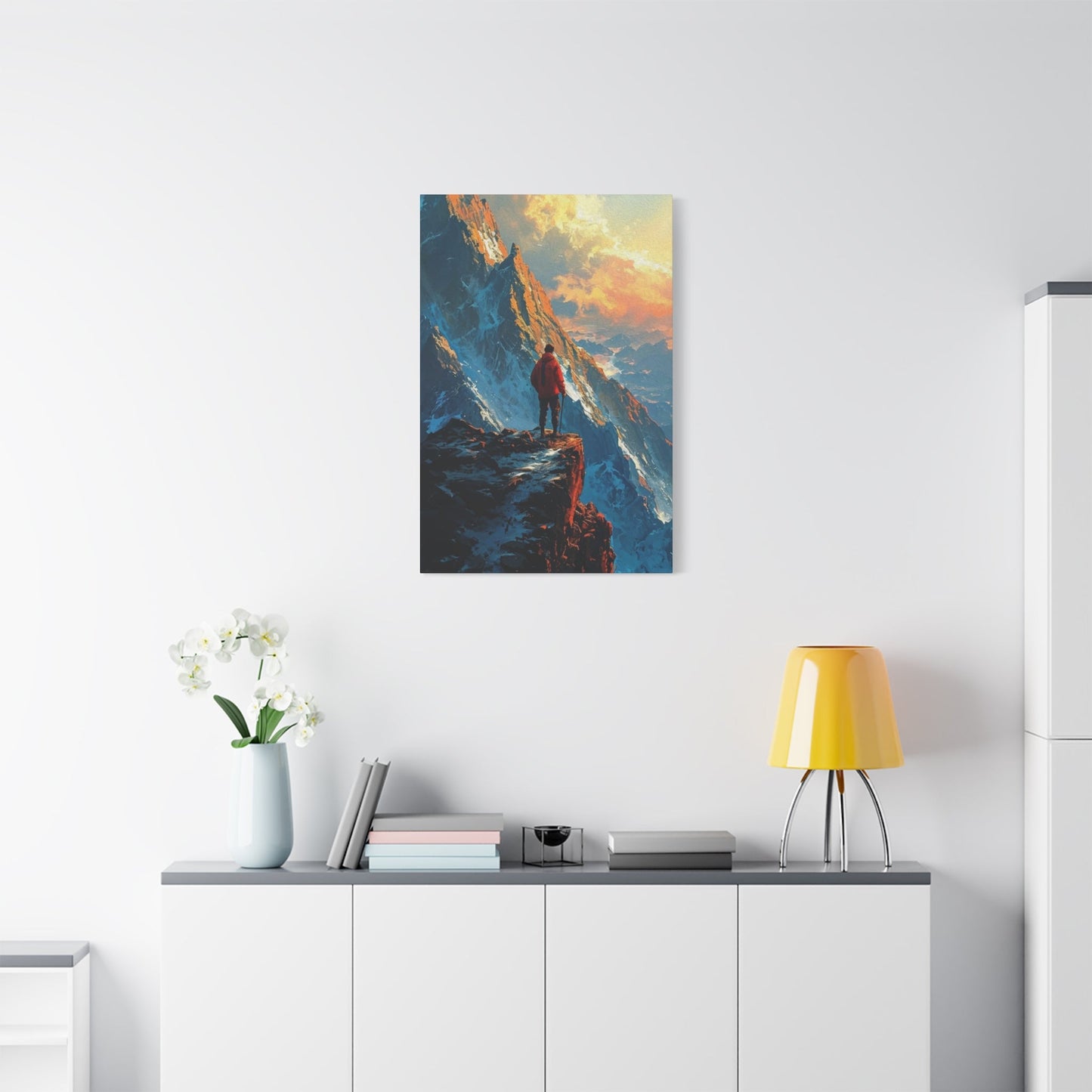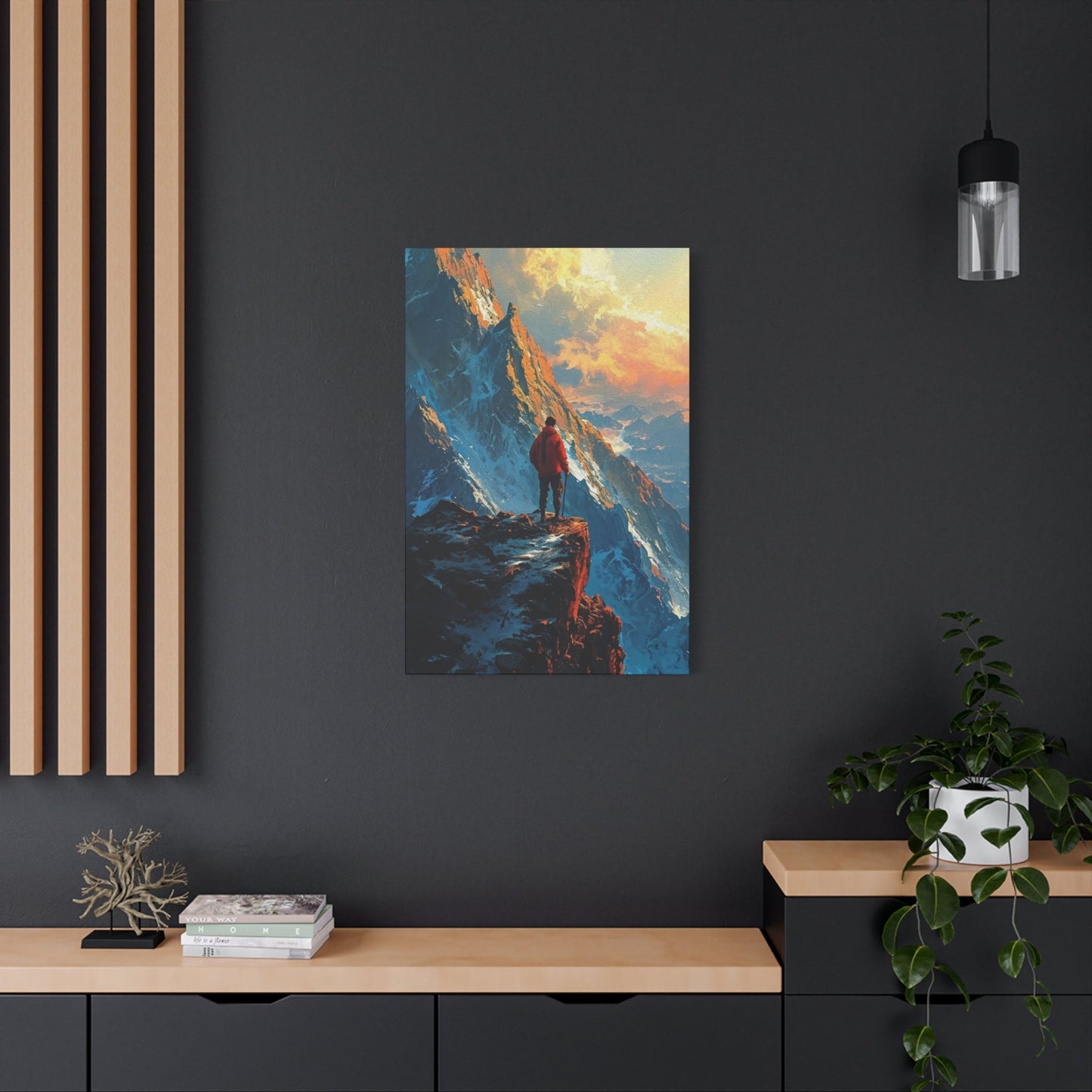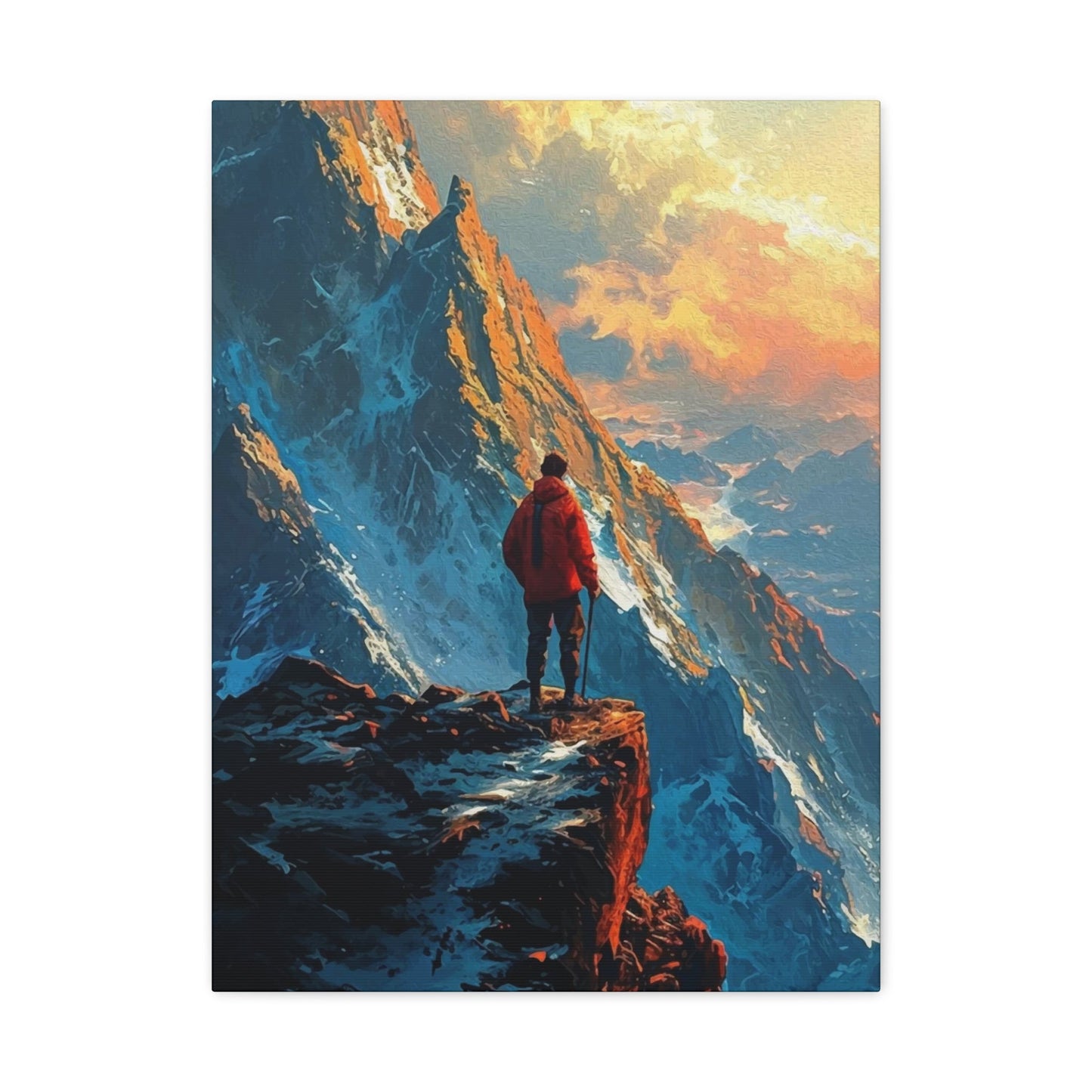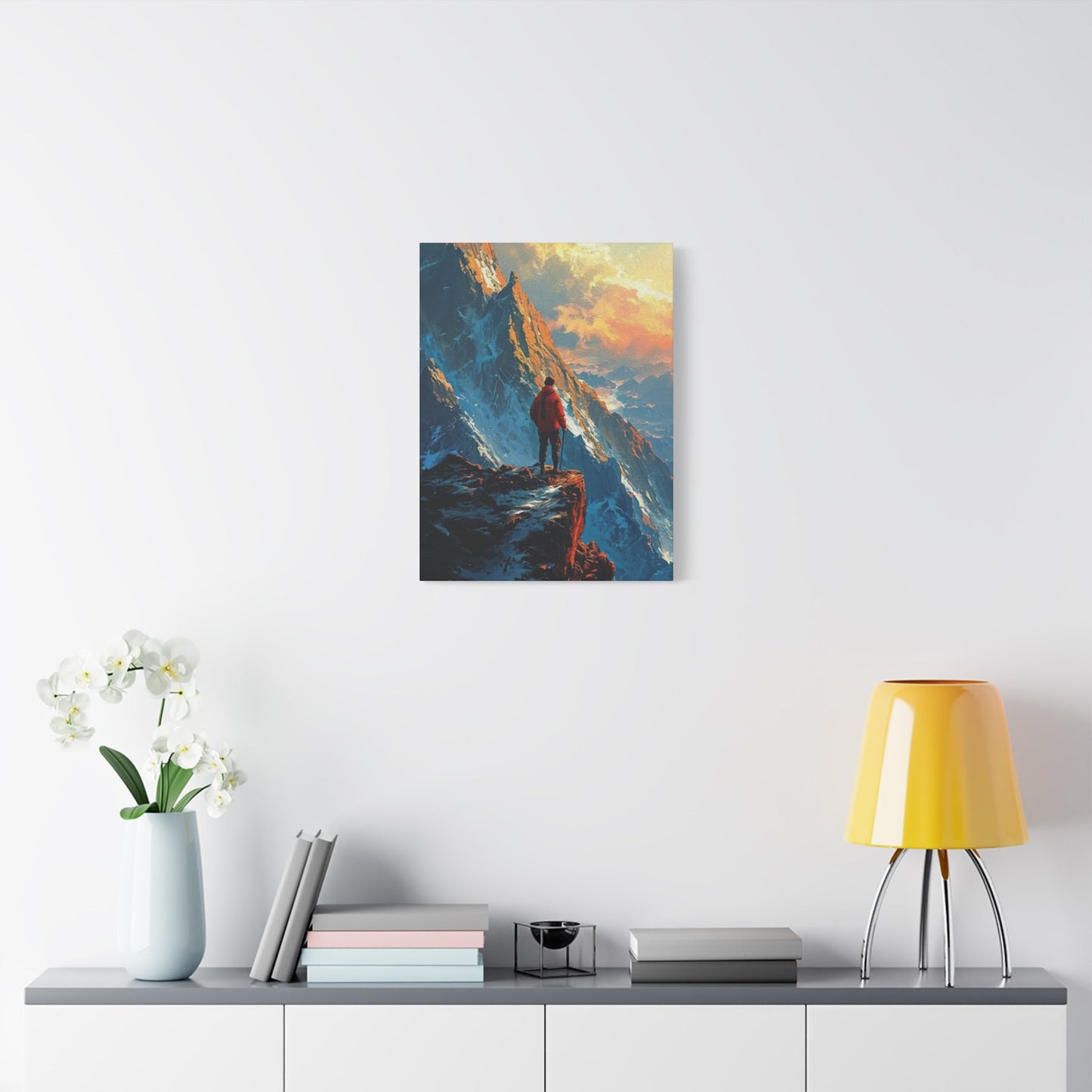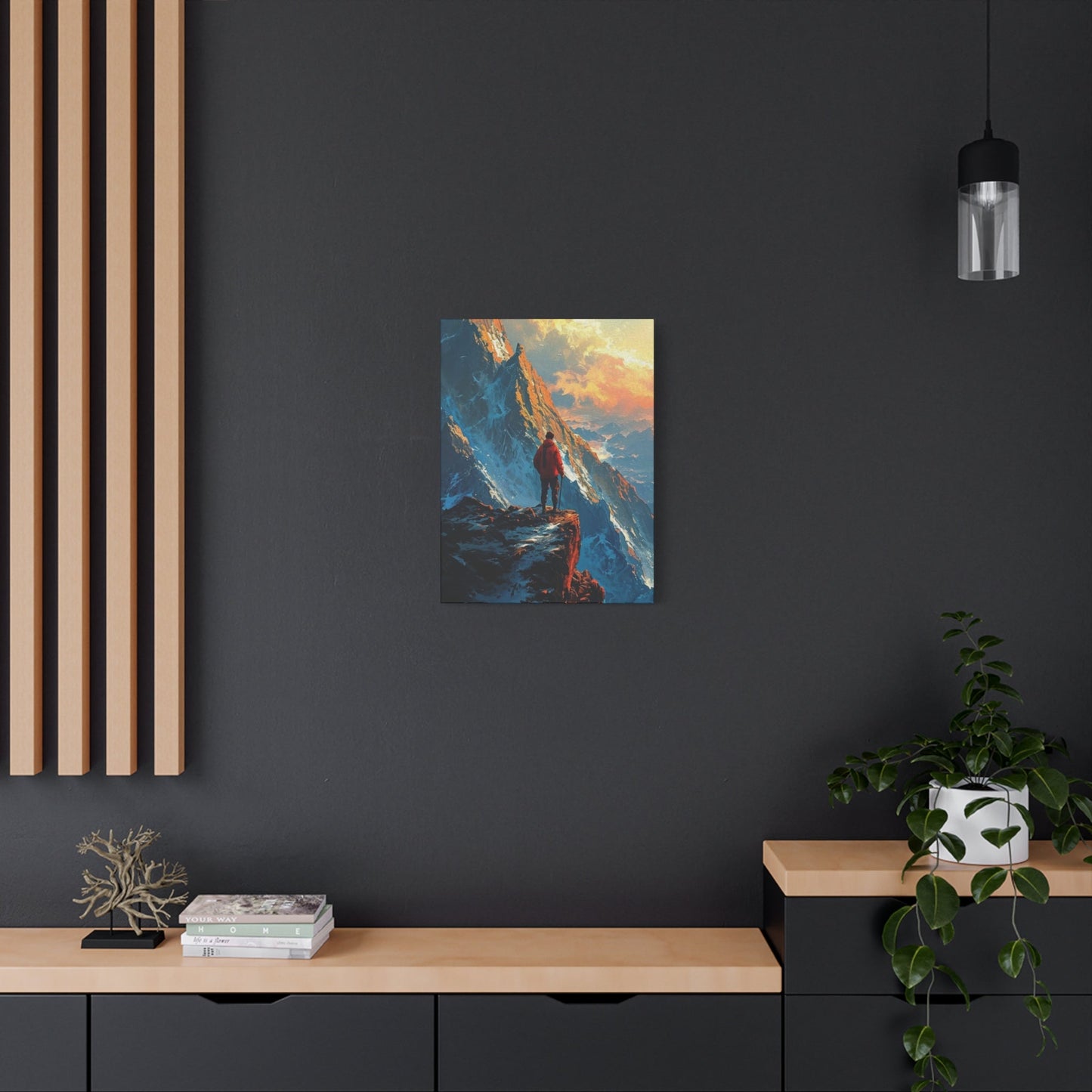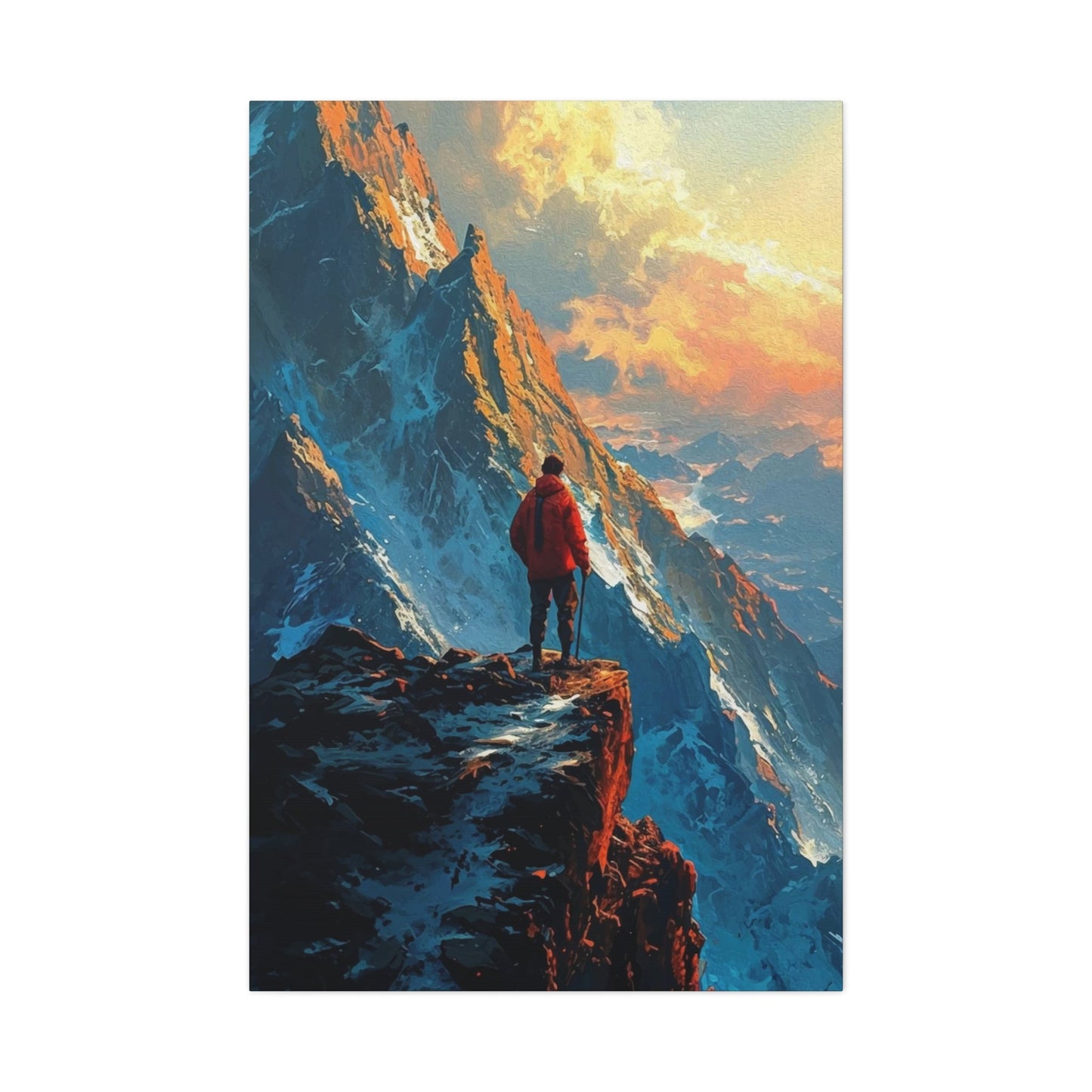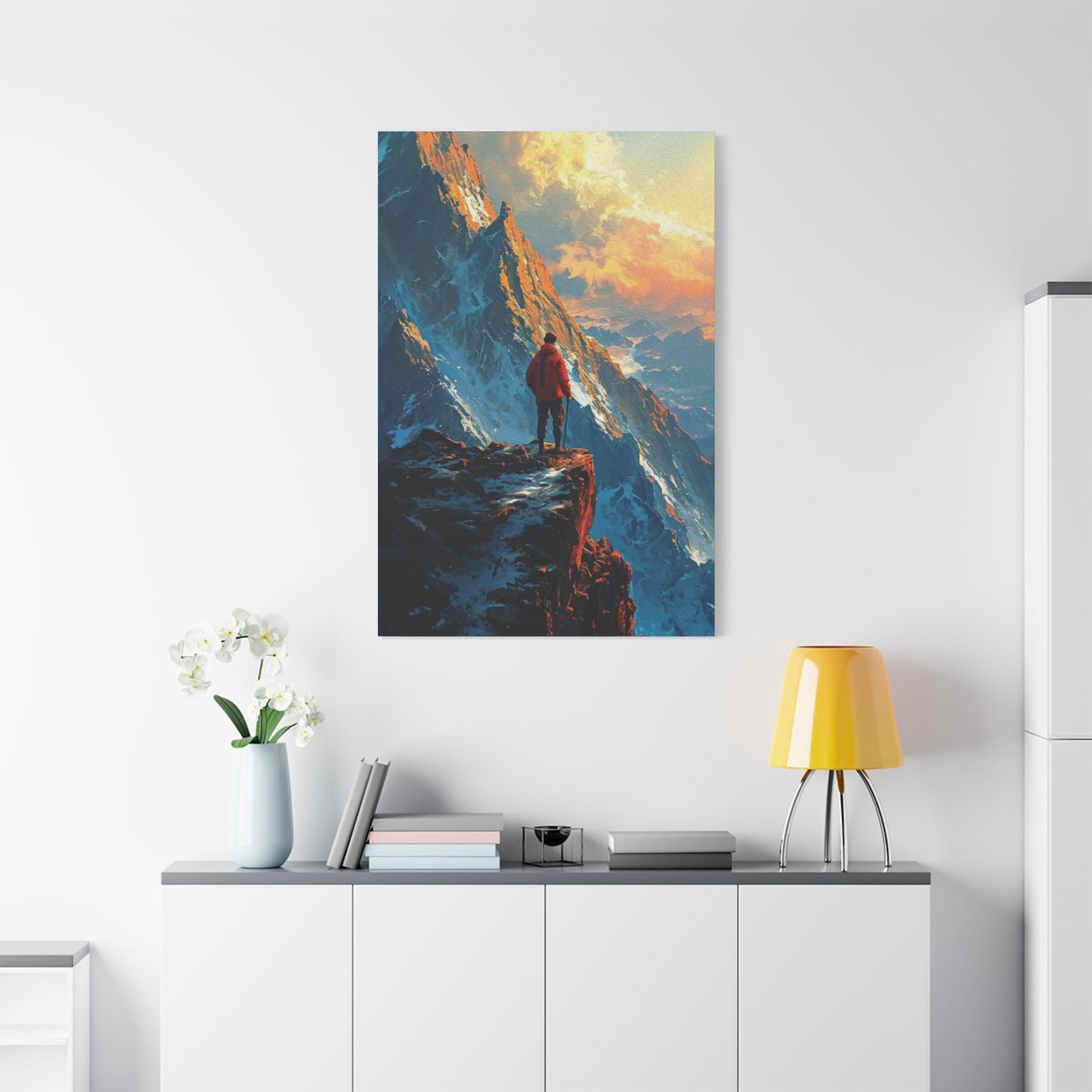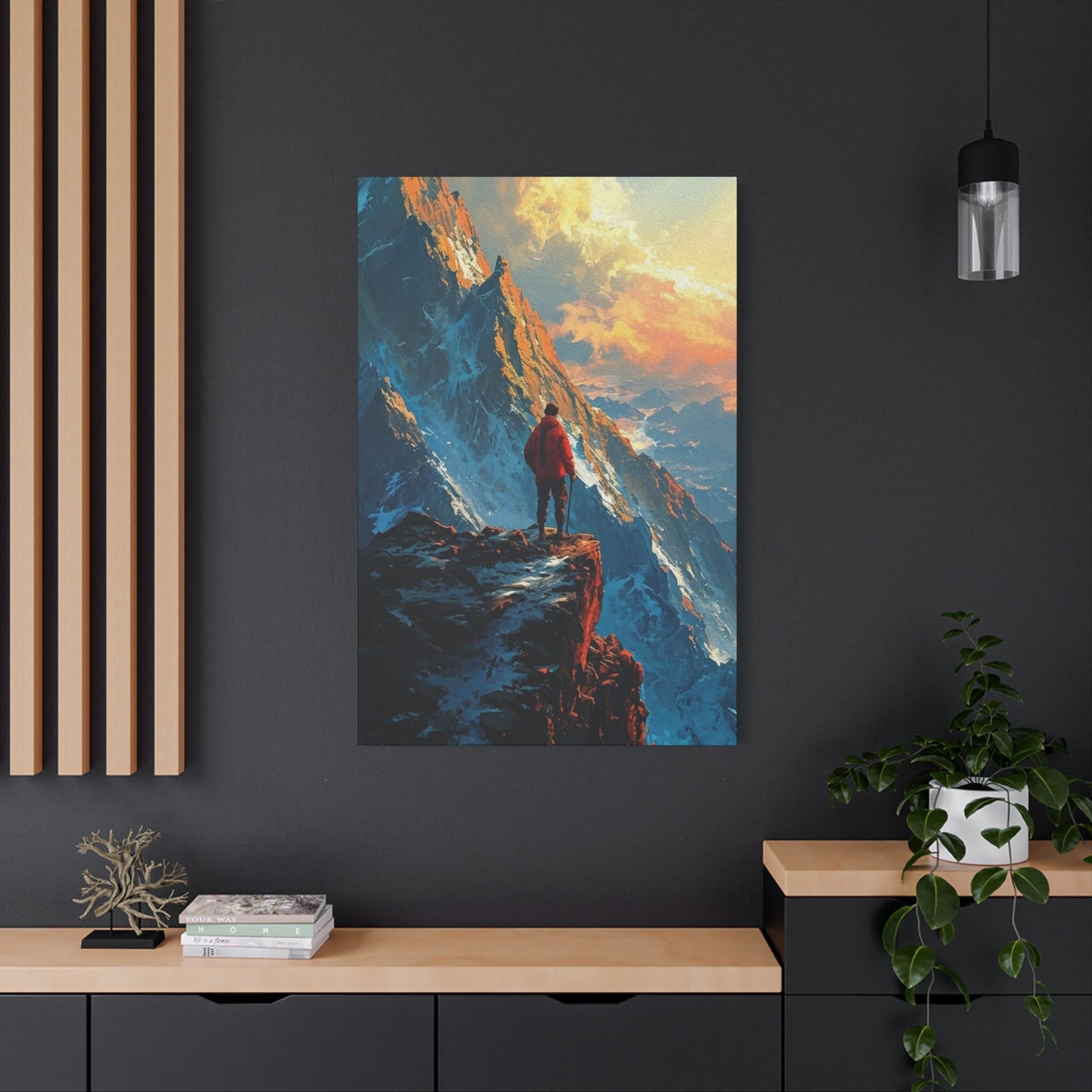Discovering the Profound Appeal of Man in Mountains Wall Art
The captivating allure of man in mountains wall art transcends mere decoration, embodying humanity's eternal relationship with nature's most majestic formations. These artistic expressions capture profound moments where human presence harmonizes with towering peaks, creating visual narratives that resonate deeply within our collective consciousness. Whether depicting solitary figures silhouetted against magnificent summits or adventurers navigating treacherous alpine terrain, these artworks speak to something fundamental about our species' drive to explore, conquer, and find meaning within nature's grandest theater.
Contemporary interior design increasingly embraces these powerful visual statements, recognizing their capacity to transform ordinary spaces into inspiring sanctuaries. The presence of man in mountains wall art immediately elevates any environment, infusing it with a sense of adventure, contemplation, and connection to the natural world. These pieces serve as constant reminders of life's grander possibilities, encouraging viewers to embrace their own inner explorer while finding solace in the timeless beauty of alpine landscapes.
The psychological impact of displaying such artwork cannot be understated. Studies consistently demonstrate that images of natural landscapes, particularly those featuring human elements, promote feelings of calm, inspiration, and renewed perspective. When we gaze upon these depictions of individuals traversing mountain paths or standing triumphantly atop distant peaks, we unconsciously project ourselves into these scenarios, experiencing vicarious adventures that enrich our daily lives.
The Rich Heritage Behind Mountain-Themed Artistic Expression
Throughout centuries, artists have been drawn to the compelling drama of human figures set against mountainous backdrops. This tradition stems from humanity's complex relationship with these towering geological formations, which have simultaneously represented obstacles to overcome and spiritual destinations to achieve. Ancient cave paintings often depicted hunters navigating mountain passes, while Renaissance masters incorporated alpine scenes to convey themes of human determination and divine inspiration.
The Romantic movement of the 18th and 19th centuries particularly elevated mountain imagery to new heights of artistic significance. Painters like Caspar David Friedrich revolutionized landscape art by placing solitary figures within vast mountain vistas, creating compositions that spoke to themes of isolation, contemplation, and humanity's place within the natural order. These works established visual vocabulary that continues to influence contemporary man in mountains wall art, emphasizing the emotional resonance of human presence within overwhelming natural settings.
Modern interpretations have expanded this tradition to encompass various artistic styles and mediums. Photography, in particular, has opened new possibilities for capturing authentic moments of human interaction with mountain environments. Documentary photographers and adventure photographers have created stunning portfolios that celebrate both the grandeur of mountain landscapes and the courage of those who venture into these challenging territories.
Understanding Different Styles of Man in Mountains Wall Art
The diversity of styles available in man in mountains wall art ensures that every space can find its perfect match. Traditional representational works continue to dominate the market, offering viewers instantly recognizable scenes of climbers scaling cliff faces, hikers traversing alpine meadows, or contemplative figures surveying distant peaks. These pieces often employ realistic painting or high-resolution photography to create immersive experiences that transport viewers directly into the mountain environment.
Abstract interpretations provide alternative approaches to the theme, using color, form, and texture to suggest rather than explicitly depict human presence within mountain settings. These works might employ bold brushstrokes to imply a figure ascending a geometric representation of a peak, or use color gradations to suggest the emotional journey of mountain exploration. Such pieces work particularly well in contemporary settings where subtle artistic statements are preferred over literal representations.
Minimalist approaches to man in mountains wall art focus on essential elements, stripping away extraneous details to concentrate on the fundamental relationship between human and mountain. These works often feature simple silhouettes against stark backgrounds, creating powerful visual statements that rely on composition and negative space rather than intricate detail. The resulting pieces possess timeless qualities that complement both modern and traditional interior designs.
Mixed media creations combine multiple artistic mediums to create layered, textured representations of mountain scenes. These might incorporate photographic elements with painted overlays, or combine relief sculptural elements with traditional flat surfaces. Such works add dimensional interest to wall displays while creating unique focal points that generate ongoing visual interest.
Selecting the Perfect Size and Scale for Your Space
Determining appropriate dimensions for man in mountains wall art requires careful consideration of both the intended display location and the desired visual impact. Large-scale pieces, typically measuring 36 inches or more in their longest dimension, work exceptionally well in spacious rooms with high ceilings, such as living rooms, great rooms, or hotel lobbies. These substantial artworks can serve as commanding focal points that anchor entire decorating schemes while creating dramatic visual statements that reflect the grandeur of their mountain subjects.
Medium-sized pieces, ranging from 18 to 36 inches, offer versatility that makes them suitable for most residential settings. These works provide sufficient visual presence to create impact without overwhelming smaller spaces, making them ideal for bedrooms, home offices, or dining areas. The moderate scale allows for closer viewing of artistic details while maintaining appropriate proportional relationships with surrounding furnishings.
Smaller works, under 18 inches in their longest dimension, excel as accent pieces or components of gallery wall arrangements. Multiple small man in mountains wall art pieces can be grouped to create compelling collections that tell broader stories about mountain exploration or human interaction with alpine environments. These arrangements offer flexibility for future reconfiguration while allowing collectors to gradually build comprehensive displays over time.
When planning installations, consider the viewing distance from the artwork to ensure optimal visual experience. Large pieces require adequate distance for full appreciation, while smaller works benefit from closer positioning that allows viewers to appreciate fine details and subtle artistic elements.
Color Schemes and Their Impact on Room Atmosphere
The color palette chosen for man in mountains wall art significantly influences the overall atmosphere of any space. Cool color schemes, dominated by blues, grays, and whites, evoke the crisp, pristine quality of high-altitude environments while promoting feelings of calm and serenity. These palettes work particularly well in bedrooms, meditation spaces, or areas designated for relaxation and contemplation.
Warm color schemes, featuring earth tones, golden hour lighting, and sunset hues, create more energetic and welcoming atmospheres. These palettes suggest the warmth of base camps, the golden light of alpine dawns, and the cozy comfort of mountain lodges. Such color schemes complement rustic or traditional decorating styles while adding inviting warmth to potentially sterile modern spaces.
Monochromatic schemes, particularly those executed in black and white or sepia tones, offer sophisticated elegance that transcends specific decorating styles. These timeless approaches to man in mountains wall art ensure longevity and versatility while creating striking visual statements that won't compete with other design elements in the room.
High-contrast color schemes create dynamic visual energy that can energize spaces and create focal points that command attention. These might feature stark silhouettes against brilliantly colored skies or vibrant clothing against muted mountain backgrounds. Such approaches work well in contemporary settings where bold artistic statements are desired.
Material Considerations for Longevity and Quality
The substrate and printing materials used in creating man in mountains wall art directly impact both the visual quality and longevity of the finished piece. Museum-quality photographic prints on archival paper ensure color stability and fade resistance over decades, making them excellent investments for serious collectors or permanent installations. These materials resist deterioration from ultraviolet light exposure and environmental factors that can compromise lesser materials.
Canvas prints offer textural interest and authentic artistic appearance that many prefer over traditional photographic papers. Modern canvas printing processes use archival inks and protective coatings that ensure durability while maintaining the tactile appeal of traditional painted canvases. The texture of canvas adds dimensional interest that enhances the viewing experience and creates authentic artistic presence.
Metal prints represent cutting-edge printing processes that create incredibly vibrant colors and sharp detail reproduction. These prints offer exceptional durability and fade resistance while providing contemporary aesthetic appeal. The reflective qualities of metal substrates can enhance the luminous quality of mountain scenes, particularly those featuring snow, ice, or bright skies.
Acrylic mounting systems create sleek, modern presentations that protect the artwork while adding visual depth through the transparent acrylic layer. These mounting methods work particularly well with photographic man in mountains wall art, as they enhance color saturation and create gallery-quality presentations suitable for both residential and commercial settings.
Framing Options That Enhance Mountain Artwork
Selecting appropriate framing for man in mountains wall art requires balancing protective function with aesthetic enhancement. Traditional wooden frames in natural finishes complement the organic themes of mountain artwork while providing classic appeal that works across various decorating styles. Rustic wood frames with visible grain patterns or weathered finishes particularly suit pieces that emphasize the rugged, natural aspects of mountain environments.
Contemporary metal frames offer sleek, minimalist presentations that allow the artwork to speak for itself without visual competition from ornate framing elements. Thin metal frames in black, silver, or white create clean lines that complement modern interiors while providing necessary protection for the mounted artwork.
Matting considerations play crucial roles in the overall presentation of framed mountain art. Wide mats create breathing space around the image while adding formal presentation quality, while narrow mats provide more intimate viewing experiences. Colored mats can either complement the artwork's existing color scheme or provide subtle contrast that enhances specific elements within the composition.
Float mounting creates the impression that the artwork is suspended within the frame, adding dimensional interest and contemporary appeal. This mounting method works particularly well with photographic prints or mixed media pieces where the edges of the artwork contribute to the overall aesthetic impact.
Placement Strategies for Maximum Visual Impact
Strategic placement of man in mountains wall art can dramatically enhance its visual impact while improving the overall flow and functionality of any space. Eye-level positioning ensures optimal viewing angles for most observers, but this standard rule can be modified based on specific circumstances and desired effects. In spaces with high ceilings, positioning artwork slightly above standard eye level can create more dramatic presentations while better utilizing vertical wall space.
Lighting considerations play crucial roles in artwork placement, as proper illumination can dramatically enhance the viewing experience while inadequate lighting can diminish even the finest pieces. Natural lighting from windows can beautifully illuminate man in mountains wall art during daylight hours, but care must be taken to avoid direct sunlight that could cause fading over time. Artificial lighting systems, including track lighting, picture lights, or strategically placed lamps, can provide consistent illumination that enhances the artwork regardless of time of day.
Grouping multiple pieces of mountain-themed artwork creates cohesive visual statements that can anchor entire decorating schemes. Gallery wall arrangements allow for creative combinations of different sizes, styles, and subjects while maintaining thematic unity through shared mountain imagery. These arrangements work particularly well in hallways, stairwells, or large wall spaces that benefit from distributed visual interest.
Contrast considerations ensure that man in mountains wall art stands out effectively against its background. Light-colored artwork benefits from darker wall colors that provide contrast, while dark or dramatic pieces may require lighter backgrounds to prevent visual merger with the wall surface. Textured wall treatments can add interest but should be subtle enough to avoid competing with the artwork for visual attention.
Creating Cohesive Mountain-Themed Interior Designs
Building entire interior design schemes around man in mountains wall art creates cohesive, immersive environments that celebrate the spirit of mountain exploration and natural beauty. This approach begins with understanding the color palette and mood conveyed by the primary artwork, then extends these elements throughout the space via complementary furnishings, textiles, and decorative accessories.
Natural materials play essential roles in mountain-themed interior designs, providing authentic connections to the outdoor environments depicted in the artwork. Wood furnishings in natural finishes echo the organic elements of mountain forests, while stone accents suggest the geological foundations of mountain landscapes. These materials should be integrated thoughtfully to support rather than compete with the focal artwork.
Textile selections can reinforce mountain themes through patterns, textures, and colors that complement the artwork while adding comfort and warmth to the space. Wool throws, leather furniture, and natural fiber rugs create tactile connections to outdoor adventure gear while providing practical comfort for daily living. Patterns inspired by traditional mountain cultures, such as Native American designs or alpine motifs, can add authentic cultural connections without overwhelming the primary artistic statement.
Lighting design becomes particularly important in mountain-themed spaces, as it can recreate the dramatic lighting conditions often featured in alpine photography and painting. Warm, directional lighting can simulate golden hour conditions, while cooler lighting might evoke the crisp clarity of high-altitude environments. Layered lighting systems allow for adjustment based on desired mood and time of day.
The Role of Photography in Modern Mountain Art
Contemporary man in mountains wall art increasingly relies on photography to capture authentic moments of human interaction with alpine environments. Modern cameras and printing processes enable the creation of incredibly detailed, large-format prints that rival traditional painting in their ability to create immersive viewing experiences. The documentary nature of photography adds authenticity and immediacy that resonates strongly with contemporary audiences.
Adventure photography has emerged as a specialized field within mountain-themed wall art, featuring professional photographers who dedicate themselves to capturing extraordinary moments of human achievement in challenging mountain environments. These artists often risk personal safety to document climbers, hikers, and skiers in action, creating dramatic images that celebrate both natural beauty and human determination.
The rise of drone photography has opened entirely new perspectives for man in mountains wall art, enabling views that were previously impossible to achieve. Aerial perspectives of tiny human figures traversing vast mountain landscapes create powerful statements about scale, isolation, and the relationship between humanity and nature. These unique viewpoints add fresh possibilities to the traditional vocabulary of mountain art.
Fine art photography printing processes ensure that photographic man in mountains wall art achieves gallery-quality presentation standards. Archival inks, museum-quality papers, and professional mounting systems create prints that rival traditional artistic mediums in their longevity and visual impact. These prints can serve as centerpieces for serious art collections while maintaining the immediacy and authenticity that makes photography so compelling.
Seasonal Considerations in Mountain Wall Art Selection
The seasonal aspects depicted in man in mountains wall art can significantly influence the mood and atmosphere of interior spaces throughout the year. Winter scenes featuring figures navigating snow-covered peaks create feelings of pristine beauty and contemplative solitude that work particularly well in spaces designated for relaxation or meditation. The cool color palettes and dramatic contrasts typical of winter mountain scenes complement minimalist decorating approaches while adding visual interest to neutral color schemes.
Summer mountain scenes, with their lush meadows, clear skies, and active human figures, bring energy and optimism to interior spaces. These works often feature warmer color palettes and more complex compositions that celebrate the abundance and accessibility of mountain environments during favorable weather conditions. Such pieces work well in active family spaces or areas where positive, energetic moods are desired.
Autumn mountain artwork captures the transitional beauty of changing seasons, often featuring dramatic color contrasts between golden foliage and distant peaks. These pieces bring warmth and richness to interior spaces while suggesting themes of change, maturity, and natural cycles. The complex color palettes typical of autumn mountain scenes provide sophisticated design foundations that complement traditional decorating styles.
Spring mountain scenes celebrate renewal and fresh beginnings, often featuring human figures emerging from winter shelters or exploring newly accessible high country. These works tend to feature fresh, clean color palettes and compositions that suggest movement and growth, making them excellent choices for offices, studios, or other spaces associated with new projects and creative endeavors.
The Influence of Famous Mountain Photographers and Artists
Several renowned artists and photographers have significantly influenced the development of man in mountains wall art as a distinct genre. Ansel Adams, while primarily known for his landscape photography, occasionally included human figures in his mountain compositions, creating iconic images that demonstrate the scale and grandeur of American wilderness areas. His rigorous printing standards and commitment to tonal excellence established benchmarks that continue to influence contemporary mountain photography.
Galen Rowell revolutionized adventure photography by combining exceptional technical skill with genuine mountaineering expertise, creating images that authentically captured the experience of high-altitude exploration. His work demonstrated that man in mountains wall art could be both artistically excellent and documentarily authentic, inspiring a generation of photographers to pursue similar paths.
Contemporary artists like Marc Adamus have pushed the boundaries of mountain photography through innovative post-processing approaches that enhance the natural drama of alpine scenes. While maintaining photographic authenticity, these artists create images with painterly qualities that blur the lines between photography and traditional artistic expression.
Fine art painters continue to contribute significantly to the man in mountains wall art genre, with contemporary artists reinterpreting traditional themes through modern perspectives and techniques. These artists often focus on the emotional and spiritual aspects of human-mountain relationships, creating works that complement photographic approaches while offering different aesthetic experiences.
Regional Styles and Cultural Influences
Different geographic regions have developed distinct approaches to man in mountains wall art, reflecting local mountain cultures and artistic traditions. Alpine European styles often emphasize the pastoral aspects of mountain life, featuring figures engaged in traditional activities like shepherding, farming, or village life against dramatic mountain backdrops. These works typically employ warm, earthy color palettes and compositional approaches that celebrate the harmonious relationship between human communities and mountain environments.
American Western styles focus on themes of exploration, adventure, and individual achievement, often featuring lone figures conquering challenging peaks or traversing wild territories. These works tend to employ dramatic lighting, bold compositions, and color schemes that emphasize the scale and grandeur of American mountain ranges. The cultural emphasis on individual achievement and wilderness conquest strongly influences the mood and messaging of these pieces.
Asian approaches to mountain art often emphasize spiritual and philosophical themes, drawing from Buddhist and Taoist traditions that view mountains as sacred spaces for contemplation and enlightenment. These works frequently feature figures in meditative poses or engaged in spiritual practices within mountain settings, using subtle color palettes and minimalist compositions that promote peaceful contemplation.
Scandinavian styles often focus on the relationship between human communities and harsh mountain environments, featuring figures engaged in traditional activities like skiing, hunting, or seasonal migration. These works typically employ cool color palettes and straightforward compositional approaches that reflect the practical, no-nonsense cultural attitudes of Nordic peoples.
The Psychology of Mountain Imagery in Interior Spaces
The presence of man in mountains wall art in living or working spaces can significantly impact psychological well-being and mental state. Research consistently demonstrates that exposure to nature imagery, particularly scenes featuring natural landscapes, reduces stress levels, improves mood, and enhances cognitive function. When human figures are included in these natural scenes, the psychological benefits are often amplified as viewers can more easily project themselves into the depicted scenarios.
Mountain imagery specifically tends to evoke feelings of aspiration, challenge, and achievement, making it particularly suitable for spaces where motivation and goal-setting are important. Home offices, exercise rooms, and study areas can benefit from the inspirational qualities of man in mountains wall art, as these images serve as constant reminders of human capability and the rewards of persistence.
The scale relationships depicted in mountain art can also provide valuable perspective during challenging periods, reminding viewers that individual problems exist within larger contexts and that natural beauty and wonder continue regardless of personal circumstances. This perspective-providing quality makes mountain art particularly valuable in bedrooms, meditation spaces, or other areas designated for reflection and restoration.
Color psychology plays important roles in how mountain art affects mood and atmosphere. Cool mountain color schemes tend to promote calm, focus, and contemplative states, while warmer palettes encourage energy, optimism, and social interaction. Understanding these psychological effects allows for strategic selection of mountain artwork based on desired emotional outcomes for specific spaces.
Maintenance and Preservation of Mountain Wall Art
Proper care and maintenance ensure that man in mountains wall art retains its visual impact and monetary value over time. Different materials require specific maintenance approaches, with photographic prints being particularly sensitive to environmental factors like humidity, temperature fluctuations, and light exposure. Ultraviolet light represents the greatest threat to most printed materials, causing gradual fading that can significantly compromise image quality over time.
Professional framing with UV-filtering glazing provides essential protection for valuable prints while maintaining visual clarity and color accuracy. Museum-quality framing materials, including acid-free mats and backing boards, prevent chemical degradation that can cause discoloration and deterioration over decades. These protective measures represent worthwhile investments for significant pieces that are intended for long-term display.
Regular cleaning maintains the visual clarity of framed artwork while preventing accumulation of dust and environmental contaminants that can gradually degrade image quality. Glass surfaces should be cleaned with appropriate materials that won't scratch or streak, while frame cleaning should use methods appropriate for the specific frame materials and finishes.
Environmental monitoring helps identify potential problems before they cause irreversible damage to valuable artwork. Humidity levels should remain stable to prevent expansion and contraction cycles that can cause cracking or warping, while temperature stability prevents condensation that can promote mold growth or cause delamination in multi-layer prints.
Investment Considerations for Mountain Art Collectors
Man in mountains wall art can represent significant financial investments, particularly for pieces by renowned photographers or artists, or those with limited edition status. Understanding factors that influence artistic value helps collectors make informed decisions while building collections that provide both aesthetic enjoyment and potential financial returns. Rarity, artist reputation, print quality, and provenance all contribute to the investment potential of mountain-themed artwork.
Limited edition prints often command premium prices due to their scarcity, but the investment value depends heavily on the reputation of the artist and the desirability of the specific image. Well-known adventure photographers or fine art photographers may see their work appreciate significantly over time, while lesser-known artists may not experience similar value increases regardless of artistic merit.
Authentication and documentation play crucial roles in maintaining investment value, particularly for higher-priced pieces. Certificates of authenticity, edition information, and documented provenance help establish legitimacy and protect against forgeries that could compromise investment value. Professional appraisals may be necessary for insurance purposes or estate planning.
Market trends in outdoor recreation and interior design can influence the desirability and value of mountain-themed artwork. Growing interest in outdoor activities, adventure travel, and nature-inspired interior design generally supports demand for high-quality mountain art, while shifts in decorating trends might affect certain styles more than others.
Digital Printing Advances in Mountain Art Production
Modern printing processes have revolutionized the production of man in mountains wall art, enabling previously impossible combinations of quality, durability, and affordability. Pigment-based inkjet printing systems produce archival-quality prints with exceptional color accuracy and fade resistance, making them suitable for both commercial and fine art applications. These processes can reproduce subtle tonal gradations and fine details that rival traditional photographic printing methods.
Large-format printing capabilities enable the creation of wall-sized mountain art that would have been prohibitively expensive using traditional methods. These massive prints can serve as architectural elements that fundamentally alter the character of interior spaces while providing immersive viewing experiences that smaller works cannot achieve. The ability to produce large-scale prints economically has democratized access to museum-quality mountain art.
Substrate innovations continue to expand creative possibilities for mountain art production. Traditional paper and canvas options have been joined by metal, acrylic, wood, and fabric substrates that each offer unique aesthetic and practical advantages. These alternative substrates can enhance specific aspects of mountain imagery while providing durability and uniqueness that sets pieces apart from traditional presentations.
Color gamut improvements in modern printing systems enable reproduction of subtle color relationships that are crucial for accurate representation of mountain lighting conditions. The ability to reproduce the subtle blue tones of distant peaks, the warm golden light of alpine sunrises, or the complex color relationships in autumn mountain scenes ensures that printed reproductions maintain the emotional impact of original photographs or paintings.
Custom Commissioning of Mountain Wall Art
For those seeking truly unique man in mountains wall art, custom commissioning offers opportunities to create personalized pieces that reflect individual experiences, preferences, or specific interior design requirements. Professional photographers and artists can work with clients to develop concepts that incorporate specific mountain locations, seasonal preferences, or stylistic approaches that align with existing decor or personal aesthetics.
Location-specific commissions allow individuals to immortalize favorite mountain destinations or meaningful experiences in high-quality artistic form. Whether commemorating a successful climb, celebrating a favorite hiking destination, or capturing the essence of a memorable mountain vacation, custom artwork provides personal significance that mass-produced pieces cannot match.
Stylistic customization enables clients to specify artistic approaches that complement existing interior designs or personal aesthetic preferences. Artists can adjust color palettes, compositional approaches, or processing styles to ensure that finished pieces integrate seamlessly into intended display environments while maintaining artistic integrity and visual impact.
Size and format customization ensures that commissioned pieces fit perfectly into designated display spaces while achieving desired visual impact. Artists can create works in specific dimensions or aspect ratios that work optimally within architectural constraints while maintaining compositional effectiveness and artistic quality.
The Environmental Message in Mountain Art
Many contemporary examples of man in mountains wall art carry implicit or explicit environmental messages that reflect growing awareness of climate change and human impact on mountain ecosystems. These works often juxtapose human presence with pristine natural environments, creating visual statements about the relationship between human activity and environmental preservation.
Conservation themes appear frequently in modern mountain art, with artists using their platforms to advocate for protection of wilderness areas and sustainable outdoor recreation practices. These works might feature subtle indicators of environmental stress, such as retreating glaciers or altered vegetation patterns, while maintaining their primary function as inspiring artistic statements.
The documentary aspect of much contemporary mountain photography inadvertently creates historical records of changing mountain environments, providing valuable documentation of glacial retreat, seasonal pattern changes, and other climate-related phenomena. These images serve dual purposes as artistic statements and environmental documentation.
Educational value emerges from mountain art that accurately depicts fragile mountain ecosystems and the careful practices required to preserve them for future generations. Viewers of such art often develop increased appreciation for mountain environments and greater awareness of their vulnerability to human impact.
Incorporating Mountain Art into Different Room Types
Living rooms provide ideal venues for large-scale man in mountains wall art that can serve as focal points for entire decorating schemes. The generous wall space typical of living areas allows for substantial pieces that create dramatic visual statements while complementing furniture arrangements and traffic patterns. Seating arrangements can be oriented to take advantage of the artwork while maintaining conversational groupings.
Bedrooms benefit from mountain art that promotes calm, contemplative moods conducive to rest and relaxation. Scenes featuring peaceful mountain lakes, distant peaks bathed in soft light, or solitary figures in meditative poses can create tranquil atmospheres that support quality sleep and peaceful awakening. Color schemes should complement existing bedding and window treatments while maintaining soothing qualities.
Home offices gain inspirational benefits from mountain art that evokes themes of challenge, achievement, and perseverance. Images of figures successfully navigating difficult terrain or reaching mountain summits can serve as motivational reminders during challenging work periods. The scale and drama of mountain environments can provide valuable perspective during stressful work situations.
Dining areas can accommodate mountain art that enhances social interactions while creating pleasant viewing experiences during meals. Works featuring groups of people sharing mountain experiences or celebrating achievements can reinforce themes of community and shared adventure that complement dining occasions.
The Craftsmanship Behind Quality Mountain Prints
Creating exceptional man in mountains wall art requires careful attention to numerous technical and artistic factors that separate professional-quality work from amateur efforts. Color calibration ensures accurate reproduction of subtle mountain lighting conditions, while proper exposure and contrast adjustments maintain detail in both shadow and highlight areas that are crucial for mountain photography.
Print resolution must be sufficient to support the intended display size without visible pixelation or quality degradation. This requires careful calculation of source file resolution relative to final print dimensions, with different substrate materials having varying resolution requirements for optimal quality.
Paper and ink selection significantly impact both the immediate visual quality and long-term durability of finished prints. Archival materials ensure fade resistance and prevent yellowing or color shifts that can compromise artwork over time. Professional-grade printers and inks produce superior color accuracy and tonal gradation compared to consumer-level equipment.
Finishing processes, including mounting, matting, and framing, require professional expertise to ensure optimal presentation and protection. Poor mounting can cause wrinkles, bubbles, or premature deterioration, while inappropriate matting materials can cause chemical staining over time.
Gallery Wall Concepts with Mountain Themes
Creating gallery walls centered around man in mountains wall art allows for comprehensive exploration of mountain themes while accommodating multiple pieces in unified presentations. Successful gallery walls require careful planning of spacing, scale relationships, and thematic connections between individual pieces while maintaining visual coherence across the entire arrangement.
Chronological arrangements can tell stories of mountain adventures over time, seasonal changes in mountain environments, or the progression of mountain exploration techniques. These narrative approaches create engaging viewing experiences that reward extended observation while providing educational value about mountain environments or outdoor recreation.
Style mixing within mountain-themed gallery walls can create dynamic visual interest while demonstrating the versatility of mountain subject matter across different artistic approaches. Combining photographic pieces with painted works, or mixing black and white images with color pieces, creates sophisticated presentations that showcase the breadth of artistic possibility within mountain themes.
Scale progression strategies use systematic changes in piece sizes to create visual rhythm and movement within gallery wall arrangements. These approaches can draw viewers through the display while creating focal points and rest areas that enhance the overall viewing experience.
The Role of Lighting in Mountain Art Display
Proper lighting dramatically enhances the viewing experience of man in mountains wall art while protecting valuable pieces from damage caused by inappropriate illumination. Natural lighting during daylight hours can beautifully illuminate mountain scenes, but must be carefully controlled to prevent direct sunlight exposure that can cause fading and deterioration over time.
Artificial lighting systems provide consistent illumination regardless of time of day or weather conditions, enabling optimal viewing at all times. Track lighting systems offer flexibility for adjusting light direction and intensity based on specific artworks and viewing conditions, while picture lights provide dedicated illumination for individual pieces.
Color temperature considerations ensure that artificial lighting enhances rather than distorts the color relationships within mountain artwork. Warm lighting can enhance golden hour mountain scenes, while cooler lighting might better serve pieces featuring snow, ice, or blue-hour conditions. Adjustable lighting systems provide flexibility for optimizing illumination based on specific pieces and desired moods.
Lighting intensity must be sufficient for comfortable viewing without being so bright as to cause glare or eye strain. Professional lighting design considers viewing distances, ambient lighting conditions, and the reflective properties of different glazing materials to achieve optimal illumination levels.
Trends in Contemporary Mountain Wall Art
Current trends in man in mountains wall art reflect broader cultural shifts toward outdoor recreation, environmental awareness, and experiential living. Minimalist approaches that focus on essential elements of human-mountain relationships appeal to contemporary design sensibilities while creating timeless artistic statements that transcend specific decorating trends.
Drone photography has introduced entirely new perspectives to mountain art, creating images that would have been impossible to achieve through traditional ground-based photography. These aerial viewpoints often emphasize the scale relationships between human figures and vast mountain landscapes, creating powerful statements about human presence within natural environments.
Mixed media approaches combine photographic elements with painted, drawn, or digitally manipulated components to create unique artistic statements that blur traditional boundaries between different artistic mediums. These experimental approaches appeal to collectors seeking distinctive pieces that stand apart from conventional mountain photography or painting.
Instagram and social media influences have shaped contemporary mountain art preferences, with artists and collectors increasingly drawn to images that translate well to digital sharing platforms. This has led to emphasis on bold compositions, dramatic lighting, and immediately recognizable mountain landmarks that perform well in social media contexts.
Mountain Art in Commercial Spaces
Hotels, restaurants, and other commercial establishments increasingly recognize the value of man in mountains wall art for creating distinctive atmospheres that appeal to adventure-oriented clientele. These installations must balance artistic merit with practical considerations like durability, maintenance requirements, and broad appeal across diverse customer bases.
Scale considerations become particularly important in commercial settings, where artwork must create impact across large spaces while remaining visible and engaging from various viewing distances. Large-format installations or multiple coordinated pieces often work better than single smaller works in commercial environments.
Thematic coordination with business identities can enhance the effectiveness of mountain art in commercial settings. Ski lodges, outdoor gear retailers, and adventure travel companies can use mountain artwork to reinforce their brand identities while creating immersive environments that support their business objectives.
Durability requirements in high-traffic commercial environments may necessitate different material choices and protective measures compared to residential installations. UV-filtering glazing, vandal-resistant mounting systems, and easy-to-clean surfaces become more important considerations in commercial applications.
The Therapeutic Value of Mountain Imagery
Healthcare facilities and wellness centers increasingly incorporate man in mountains wall art to support healing environments and promote positive mental health outcomes. Research demonstrates that exposure to nature imagery can reduce anxiety, lower blood pressure, and improve recovery times for various medical conditions.
Stress reduction benefits of mountain imagery stem from evolutionary psychological responses to natural environments that signal safety, resources, and positive outcomes. The presence of human figures in mountain scenes can enhance these benefits by providing relatable elements that allow viewers to project themselves into peaceful, beautiful environments.
Meditation and mindfulness practices can be enhanced by contemplation of mountain art, with the timeless quality of mountain landscapes providing focal points for mindful attention and present-moment awareness. The scale and permanence of mountains can provide perspective during difficult personal circumstances while promoting acceptance and resilience.
Color therapy principles can be applied to mountain art selection for therapeutic environments, with different color palettes supporting various healing objectives. Cool blues and whites promote calm and reduce agitation, while warmer earth tones encourage feelings of security and grounding.
Seasonal Rotation Strategies for Mountain Art
Rotating displays of man in mountains wall art throughout the year can maintain visual interest while reflecting seasonal changes in natural environments. This approach allows collectors to enjoy various pieces while preventing visual staleness that can occur with permanent installations.
Storage considerations for artworks not currently displayed require climate-controlled environments that protect against humidity, temperature fluctuations, and pest damage. Professional storage solutions or careful home storage can preserve artwork quality during periods when pieces are not actively displayed.
Seasonal coordination with interior decor changes can enhance the overall cohesiveness of living spaces while celebrating natural rhythms and cycles. Winter mountain scenes complement cozy textiles and warm lighting, while summer mountain art pairs well with lighter fabrics and brighter color schemes.
Documentary value emerges from collections that comprehensively document seasonal changes in specific mountain locations, creating educational resources that demonstrate natural cycles and environmental patterns. These collections can serve dual purposes as artistic displays and environmental education tools.
International Perspectives on Mountain Art
Different cultures worldwide have developed unique approaches to depicting human relationships with mountain environments, reflecting varying philosophical, spiritual, and practical perspectives on these dramatic landscapes. Japanese mountain art often emphasizes harmony, minimalism, and spiritual transcendence, drawing from Zen Buddhist traditions that view mountains as sacred spaces for contemplation.
Himalayan artistic traditions incorporate elements of Tibetan Buddhism and Hindu philosophy, often featuring figures engaged in pilgrimage or spiritual practice within mountain settings. These works typically employ symbolic elements and color schemes that carry religious significance while celebrating the sacred nature of high-altitude environments.
European alpine art traditions emphasize the pastoral and recreational aspects of mountain environments, reflecting cultural perspectives that view mountains as resources for both practical use and aesthetic enjoyment. These works often feature traditional activities like shepherding, farming, or mountaineering within idealized mountain settings.
Native American mountain art traditions incorporate spiritual and ceremonial elements that reflect deep cultural connections to specific mountain locations. These works often feature traditional activities and symbolic elements that communicate cultural values and relationships with sacred mountain sites.
Conclusion
“Man in Mountains” wall art offers a compelling way to explore the connection between humanity and the majesty of nature, transforming interiors into spaces of reflection, inspiration, and visual grandeur. By depicting solitary figures amidst towering peaks, sweeping landscapes, or rugged terrains, this style of art captures both the physical scale of mountains and the emotional resonance of human presence within vast natural environments. Whether displayed in living rooms, bedrooms, offices, or creative spaces, this artwork elevates interiors by blending aesthetic beauty with profound narrative depth, inspiring contemplation and admiration for the natural world.
The appeal of “Man in Mountains” wall art lies in its ability to merge realism, symbolism, and artistic interpretation. Artists focus on composition, light, shadow, and scale to emphasize the contrast between human fragility and the enduring strength of mountainous landscapes. Subtle details in posture, clothing, or perspective invite viewers to connect emotionally with the lone figure, while the grandeur of the surrounding scenery evokes awe, tranquility, and introspection. Through thoughtful use of color, texture, and form, each piece becomes an immersive experience that celebrates both the majesty of nature and the resilience of the human spirit.
Beyond its visual allure, this type of wall art carries significant symbolic meaning. Mountains often represent challenges, aspirations, and enduring strength, while the solitary figure embodies introspection, perseverance, and the human quest for meaning. Incorporating “Man in Mountains” art into interiors fosters mindfulness, reflection, and emotional engagement, creating spaces where viewers can feel both grounded and inspired. Each piece encourages exploration of personal journeys, ambition, and the relationship between humanity and the natural world, making it a meaningful addition to any room.
From a design perspective, “Man in Mountains” wall art is versatile and adaptable. Large canvases make dramatic statements in living rooms or offices, while smaller pieces or series arrangements complement hallways, reading nooks, or bedrooms. The natural color palettes, dynamic perspectives, and textured detailing allow the artwork to harmonize with modern, rustic, minimalist, or eclectic interiors, adding both visual interest and narrative depth.
Ultimately, “Man in Mountains” wall art is more than decoration—it is a celebration of human spirit, nature’s grandeur, and artistic expression. By incorporating these works into home or office interiors, individuals can create walls that inspire reflection, evoke emotion, and cultivate a profound connection between humanity and the natural world. Each piece transforms ordinary spaces into environments of beauty, contemplation, and enduring significance.

















